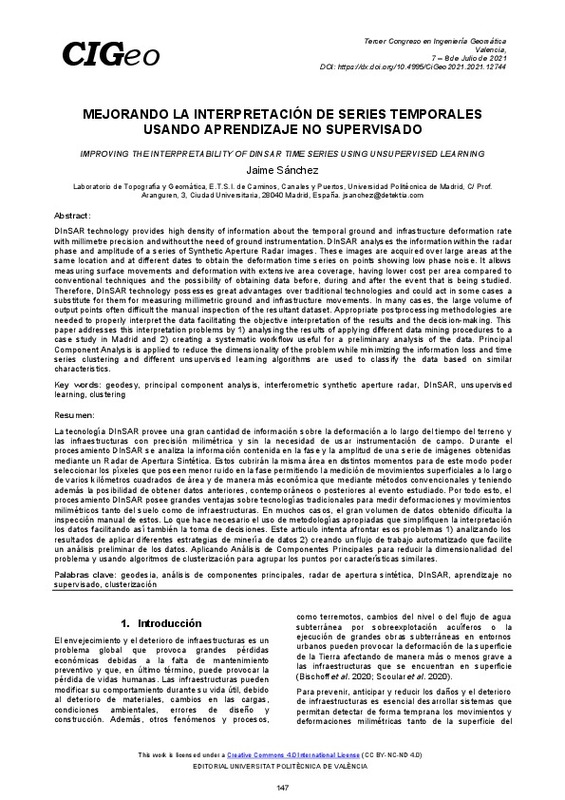JavaScript is disabled for your browser. Some features of this site may not work without it.
Buscar en RiuNet
Listar
Mi cuenta
Estadísticas
Ayuda RiuNet
Admin. UPV
Mejorando la interpretación de series temporales usando aprendizaje no supervisado
Mostrar el registro sencillo del ítem
Ficheros en el ítem
| dc.contributor.author | Sánchez, Jaime
|
es_ES |
| dc.date.accessioned | 2021-10-13T12:30:44Z | |
| dc.date.available | 2021-10-13T12:30:44Z | |
| dc.date.issued | 2021-10-01 | |
| dc.identifier.isbn | 9788490489611 | |
| dc.identifier.uri | http://hdl.handle.net/10251/174587 | |
| dc.description.abstract | [EN] DInSAR technology provides high density of information about the temporal ground and infrastructure deformation rate with millimetre precision and without the need of ground instrumentation. DInSAR analyses the information within the radar phase and amplitude of a series of Synthetic Aperture Radar images. These images are acquired over large areas at the same location and at different dates to obtain the deformation time series on points showing low phase noise. It allows measuring surface movements and deformation with extensive area coverage, having lower cost per area compared to conventional techniques and the possibility of obtaining data before, during and after the event that is being studied. Therefore, DInSAR technology possesses great advantages over traditional technologies and could act in some cases a substitute for them for measuring millimetric ground and infrastructure movements. In many cases, the large volume of output points often difficult the manual inspection of the resultant dataset. Appropriate postprocessing methodologies are needed to properly interpret the data facilitating the objective interpretation of the results and the decision-making. This paper addresses this interpretation problems by 1) analysing the results of applying different data mining procedures to a case study in Madrid and 2) creating a systematic workflow useful for a preliminary analysis of the data. Principal Component Analysis is applied to reduce the dimensionality of the problem while minimizing the information loss and time series clustering and different unsupervised learning algorithms are used to classify the data based on similar characteristics. | es_ES |
| dc.description.abstract | [ES] La tecnología DInSAR provee una gran cantidad de información sobre la deformación a lo largo del tiempo del terreno y las infraestructuras con precisión milimétrica y sin la necesidad de usar instrumentación de campo. Durante el procesamiento DInSAR se analiza la información contenida en la fase y la amplitud de una serie de imágenes obtenidas mediante un Radar de Apertura Sintética. Estos cubrirán la misma área en distintos momentos para de este modo poder seleccionar los píxeles que poseen menor ruido en la fase permitiendo la medición de movimientos superficiales a lo largo de varios kilómetros cuadrados de área y de manera más económica que mediante métodos convencionales y teniendo además la posibilidad de obtener datos anteriores, contemporáneos o posteriores al evento estudiado. Por todo esto, el procesamiento DInSAR posee grandes ventajas sobre tecnologías tradicionales para medir deformaciones y movimientos milimétricos tanto del suelo como de infraestructuras. En muchos casos, el gran volumen de datos obtenido dificulta la inspección manual de estos. Lo que hace necesario el uso de metodologías apropiadas que simplifiquen la interpretación los datos facilitando así también la toma de decisiones. Este articulo intenta afrontar esos problemas 1) analizando los resultados de aplicar diferentes estrategias de minería de datos 2) creando un flujo de trabajo automatizado que facilite un análisis preliminar de los datos. Aplicando Análisis de Componentes Principales para reducir la dimensionalidad del problema y usando algoritmos de clusterización para agrupar los puntos por características similares. | es_ES |
| dc.format.extent | 8 | es_ES |
| dc.language | Español | es_ES |
| dc.publisher | Editorial Universitat Politècnica de València | es_ES |
| dc.relation.ispartof | Proceedings 3rd Congress in Geomatics Engineering | |
| dc.rights | Reconocimiento - No comercial - Sin obra derivada (by-nc-nd) | es_ES |
| dc.subject | Geocomputing | es_ES |
| dc.subject | 3D Modelling | es_ES |
| dc.subject | Cultural Heritage | es_ES |
| dc.subject | Geodesy | es_ES |
| dc.subject | Geophysics | es_ES |
| dc.subject | Earth observation | es_ES |
| dc.subject | Cartography | es_ES |
| dc.subject | Environmental applications | es_ES |
| dc.subject | Principal component analysis | es_ES |
| dc.subject | Interferometric synthetic aperture radar | es_ES |
| dc.subject | DInSAR | es_ES |
| dc.subject | Unsupervised learning | es_ES |
| dc.subject | Clustering | es_ES |
| dc.subject | Geodesia | es_ES |
| dc.subject | Análisis de componentes principales | es_ES |
| dc.subject | Radar de apertura sintética | es_ES |
| dc.subject | Aprendizaje no supervisado | es_ES |
| dc.subject | Clusterización | es_ES |
| dc.title | Mejorando la interpretación de series temporales usando aprendizaje no supervisado | es_ES |
| dc.title.alternative | Improving the interpretability of DinSAR time series using unsupervised learning | es_ES |
| dc.type | Capítulo de libro | es_ES |
| dc.type | Comunicación en congreso | es_ES |
| dc.identifier.doi | 10.4995/CiGeo2021.2021.12744 | |
| dc.rights.accessRights | Abierto | es_ES |
| dc.description.bibliographicCitation | Sánchez, J. (2021). Mejorando la interpretación de series temporales usando aprendizaje no supervisado. En Proceedings 3rd Congress in Geomatics Engineering. Editorial Universitat Politècnica de València. 147-154. https://doi.org/10.4995/CiGeo2021.2021.12744 | es_ES |
| dc.description.accrualMethod | OCS | es_ES |
| dc.relation.conferencename | 3rd Congress in Geomatics Engineering | es_ES |
| dc.relation.conferencedate | Julio 07-08, 2021 | es_ES |
| dc.relation.conferenceplace | Valencia, Spain | es_ES |
| dc.relation.publisherversion | http://ocs.editorial.upv.es/index.php/CIGeo/CiGeo2021/paper/view/12744 | es_ES |
| dc.description.upvformatpinicio | 147 | es_ES |
| dc.description.upvformatpfin | 154 | es_ES |
| dc.type.version | info:eu-repo/semantics/publishedVersion | es_ES |
| dc.relation.pasarela | OCS\12744 | es_ES |








